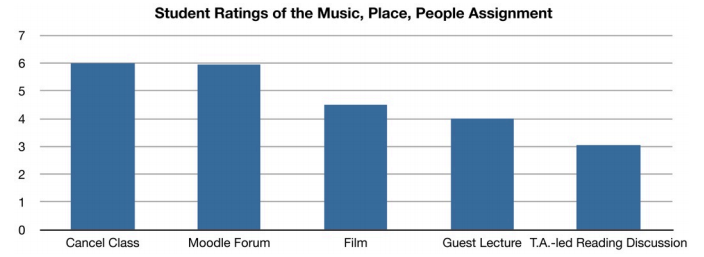Music, Place, People: Turning Conference Travel into a Teachable Moment

by Mark Pedelty and Melody Hoffman
We all face the same problem when traveling to conferences during the academic term: what to do with our classes while we’re away. Show a film? Invite a guest? Ask the TA to lead discussion? Cancel class? What if, instead of choosing one of those typical substitutes, a teacher-researcher was to bring students along to the conference, virtually speaking? That’s what Mark did last November in an undergraduate course on Communication and Popular Music, and according to an assessment carried out by Melody, the results were promising enough to share. The Music, Place, People assignment brought 27 students into conversation with scholars and artists whose work explored connections between sound, sight, and sustainability at the AMS 2013 Annual Meeting in Pittsburgh. It was assigned in a Communication and Popular Music course as part of a unit on music and the environment.
The Assignment
Students were asked to watch the music video “Legendary” on the Ecosong.org website. A bit of background is in order. “Legendary” is a collaborative, community-based music video project that deeply represents, yet broadly transcends, the Detroit locations it references throughout. Evocative visual imagery (e.g., community gardens), compelling beats, and artful lyrics invite the audience to challenge and reconsider their preconceptions of Detroit. “Legendary” is an invitation to learn from a group of women who understand, live, and embody dimensions of Detroit missing from car commercials and national news. “Legendary” was produced and performed by members of the 5 e Gallery, a hip-hop collective. The 5 e team’s work and thoughts were featured at the Ecomusicology Listening Room (ELRII) session at the AMS Annual Meeting in Pittsburgh, presented via a combination of live performance, video projection, and panel discussion.
Mark asked students to submit questions for the video producer, Piper Carter, performers Nique LoveRhodes and Mahogany Jones, as well as two Oakland University professors who have been working with the project, Rebekah Farrugia and Kellie Hay. Mark then sat down with the 5 e Gallery group to record a one-hour interview at the AMS.
A full recounting of the interview is beyond the scope and purpose of this piece. Students’ questions included contemplations of place (“It’s clear in your music that Detroit is central to the message of this music video. How do you think this music video might have been similar or different if it was about marginalization elsewhere?”), environmental messaging (“It seemed you placed a great deal of emphasis on the environment and specific images/scenes—empty pool, lock, gardens, etc. Can you speak to the relevance of these images as it pertains to the intended message of the video and/or sound?”), identity (”How does the video represent you as a person and how does that effect your music?”), and several queries related to music, beats, and lyrics. The team members’ thoughtful, reflective answers made for fascinating listening.
After listening to the interview, students were asked to take part in a Moodle forum discussion, the instructions for which are provided at the end of this post (and are edited for length):
The entire process was repeated at the Rock and Roll Hall of Fame and Museum, based on an interview with Director of Education Jason Hanley. Mark asked Jason to share his thoughts on topics in ecomusicology as well as issues specific to his work and that of student ethnographers in my class. Jason had a great deal to share with the students, who very much appreciated his thoughtful, articulate answers to their questions.
Assessment
Students were anonymously surveyed online following the assignment. Melody helped design the survey. We are currently using the data to write a pedagogical piece concerning new ways to integrate research travel and teaching, using social media and new communication technologies. Therefore, the survey was designed to assess the students’ sense of the projects’ effectiveness relative to other “substitutes” for the professor’s presence in class: canceling class, showing a film, inviting a guest lecturer, or asking the teaching assistant to lead a discussion of the reading. The numerical results of the twenty responses were as follows, on a scale from (1) very ineffective to (7) very effective, as shown in the chart below:

It is not surprising that the students’ favorite response would be to cancel class in lieu of an additional assignment. Any other aggregate response would have called this self-reported data into question. Late in the semester students would naturally prefer to be allowed to catch-up with their reading, other courses, work, and job searching. However, the Moodle Forum (i.e. this Music, Place, People assignment) came in a close second to cancelling class when the professor goes out of town for conferencing. That is a very promising sign. Other options were rated less favorably.
Positive comments about the assignment fell into four categories: interactivity, voice, convenience, and engagement. Many students appreciated seeing what goes into interview research, including one who falsely assumed that this was Mark’s research: “It was interesting to see what Dr. Pedelty was working on with his research.” Like other students, he or she also “thought the interviews were very interesting and very relevant for class.” Other students appreciated the fact that the assignment “allowed students to get insight from a long distance conference.” As is often true of online interactions, several students appreciated the opportunity to think through the material and offer a more fully rendered response than is often possible in class discussions. For example, one student explained that, “I spent a lot of time critically analyzing the interviews and coming up with questions.” Based on the quality of the actual discussion forum, it appears that most students bought-in to the exercise and gained something valuable from completing the assignment. Several felt that it was, to quote one, “a great addition to the class.”
Surprisingly, negative comments mostly cluster into the same categories. Students were concerned that others did not engage as much as they could have. A few suggested minor tweaks for the assignment. For example, one student noted: “It was easy to forget about, possibly an email reminder would have been nice!” That took Mark by surprise, because he felt as though he was practically spamming the class with updates and reminders. One student “wasn’t that interested in the topic,” and it is safe to assume that others were equally disinterested. Others stated that there were “no weaknesses” to the assignment.
Overall, the Music, People, Place assignment seemed to add an important dimension to the class while making a pedagogical virtue out of a research necessity (conference travel). “Legendary” and, most particularly, thoughts by performers Mahogany and Nique, were repeatedly mentioned during the final weeks of the semester, used by students as examples during discussions of related topics. Having been part of creating knowledge along with the participating informant-artists, producers, and scholars, the students seemed to gain a stake in the subject matter as well as a better sense of what goes into creating scholarly knowledge on the topic. The course was rated highly, with 95% stating that they would recommend it to fellow students. Yet, many students found at least a few of the main readings “dry” and a creative class assignment—recording the soundtrack for their fellow students’ music video—”a waste of time.” Those critical assessments bolster the sense that students were genuinely interested in the Music, Place, People interview assignment.
Next Steps
This assignment was far from perfect, but it seemed to advance an earlier iteration of the concept as tested in 2010. In the previous experiment, Mark spent a week using new media to teach from a field research site in Mexico City, an assignment facilitated and assessed by Melody back home on campus. There was certainly enough evidence in the assessment to warrant further development. Among ideas under consideration for the next iteration of the assignment is to put the students, artists, and musicologists in more direct conversation via Skype during the conference. However, the asynchronous and iterative aspects of Music, Place, People helped make the assignment work and made it much more manageable for the traveling instructor.
If any readers have completed similar assignments, we would love to hear about your experiences and ideas for improving assignments like Music, Place, People. (Send correspondence to Pedelty {at} umn.edu .)
---
Moodle Forum Discussion Prompt
The goals of this alternative class session and forum are to (1) complete our conversation with the 5e Foundation artists, (2) draw connections and comparisons with your ethnographic research projects, (3) learn about the relationship between social contexts, music, environment, and politics through talking about these topics with music producers, scholars, and artists. Please do the following:
1) Watch the music video again.
2) Watch the AMS panel featuring Piper Carter, Rebekah Farrugia, Kellie Hay, Mahogany Jones, and Nique LoveRhodes.
3) Listen to the interview and draw out a quote that interests you.
4) Provide a quotation by one of the interview informants.
5) React to the quote. Include any general thoughts that you have on the topic as well as how the informant’s point relates to your own research (e.g., fashion? persona? place? biography and life experience? politics? whatever strikes your interest and relates to some aspect of your research).
6) Respond to a classmate’s post as well. Let’s make this as interactive as possible.





